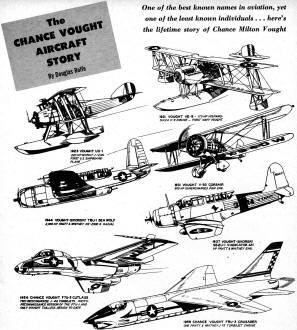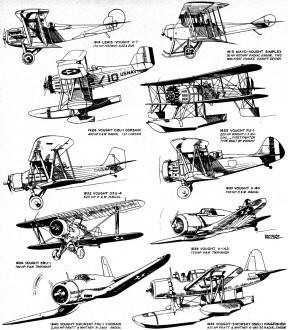|
Douglas Rolfe, who provided many detailed and line drawings of full-scale aircraft
for American Modeler magazine, here summarizes the history of Chance Vought Aircraft
Company. While the name appears to be the joint venture of two separate people,
one by the name of Chance and the other by the name of Vought, it is in fact the
namesake of Mr. Chance
Milton Vought. Another such instructional name of the same sort is Johns Hopkins
University, which is named after
Mr. Johns Hopkins. Probably
the most well-known airplane models are the F4U Corsair
and OS2U Kingfisher
of World War II and Pappy Boyington's
Black Sheep Squadron (VMA-214)
fame, and the F8U Crusader of Korean War fame. Chance Vought obviously was
really fond of the "Corsair" name since he name three separate models with it: the
1926 O2U Corsair, the 1931 V50 Corsair, and the 1940 F4U Corsair. Along with the
company history, Mr. Rolfe gives a short blurb on each airplane.
The Chance Vought Aircraft Story

Chance Vought aircraft models 1915 through 1961 (page 1)

Chance Vought aircraft models 1915 through 1961 (page 2)
By Douglas Rolfe
One of the best known names in aviation, yet one of the least known individuals
... here's the lifetime story of Chance Milton Vought.
The name of Chance Milton Vought has been associated with American aviation since
the early days when the Wright brothers taught him to fly in 1910. Son of a boat-builder,
he was born in New York City, February 26, 1890. His education was in the public
schools and at Pratt Institute, Brooklyn. He entered New York University, specializing
in engineering, and later transferred to the University of Pennsylvania.
Upon leaving college in 1910, Vought became consulting engineer for Harold F.
McCormick in Chicago, where he remained for three years in charge of experimental
developments. His aviation career began in 1910, with the Wright brothers as his
instructors. He qualified as an airplane pilot the following year and continued
to fly actively until 1917.
While working for McCormick, Vought also became consulting engineer for the Aero
Club of Illinois. His interest in aviation grew, so that he joined the Lillie Aviation
School, Chicago, in 1913 as aeronautical engineer and pilot. His versatility was
demonstrated when the following year he became editor of the pioneer American aviation
weekly, "Aero and Hydro."
He left the publishing business to become actively engaged in aeronautical designing
that same year, joining the Mayo Radiator Works in New Haven, Conn., where he designed
an advanced training plane for use by the British government during World War 1.
This Mayo-Vought Simplex biplane, although a trainer, proved to be faster than many
fighters and launched Vought in his aircraft designing career.
In 1916, he became chief engineer for the Wright Company, Dayton, Ohio, and produced
the then famous Model V military biplane. When the Wright company merged with the
Martin Company to form the Wright-Martin Aircraft Co., New York City, in 1917, he
continued with the new firm as aeronautical engineer for a time.
Vought longed to own his own company, however, and in 1917 he joined with Birdseye
B. Lewis to form the Lewis and Vought Corporation. He remained consulting engineer
and chairman of the board until 1922 when the company was succeeded by the one bearing
his name - the Chance Vought Corporation - of which he was president and consulting
engineer.
Situated in Long Island City, N. Y., the new company and its successor, the Chance
Vought Corporation, were among the leaders in American aviation industry, manufacturing
two-placed advanced training and observation planes. In 1929, the company consolidated
with Pratt & Whitney Aircraft Co., engine manufacturers of Hartford, Conn.,
and Boeing in Seattle to form United Aircraft and Transport Corp.
Chance Vought lived to see his aircraft plant housed in a 175,000-foot scientifically-designed
factory at East Hartford and turning out new and improved Corsairs for the Navy.
He died on Long Island on July 25, 1930.
The following is a list of Vought aircraft of special significance to air progress
historians.
The VE-7 (1919), Chance Vought's first production airplane, was described By
Brig.-Gen. William Mitchell: "This Vought machine, a training type, has all of the
air qualities of the single-seater chasse machines and will outmaneuver the French
Spad, the Nieuport and the English SE-5."
The VE-9 (1921) was the original catapult plane used by the Navy for observation
and gunnery spotting. When the USS Langley - the Navy's first aircraft carrier -
received its planes, it was equipped with VE-9s fitted with arresting gear for deck
landings. First deck takeoff was made by LCdr. V. C. Griffin in a VE-9 in October,
1922.
The UO-1 (1923) was one of the first airplanes to be catapulted from aboard a
battleship and the first to be issued in quantity to the Fleet. First to hook onto
a dirigible in flight, July, 1929. First Coast Guard plane was UO-1 (1925).
The FU-1 (1925) was the first military airplane equipped with an air-cooled engine
to be placed in production with a blower for high altitude work.
The 02U-1 (1926) was the first military airplane to be powered with the Pratt &
Whitney Wasp engine. It established four world records - altitude, 22,- 178 feet;
speed for 100-kilometer closed course, 147.26 mph; speed for 500-kilometer closed
course, 136 mph; and speed for 1,000-kilometer closed course, 130 mph.
The SBU-1 (1935) was the first dive bomber with a top speed of more than 200
miles an hour. First Navy plane specifically designed for both scouting and dive
bombing missions to go into service use.
The SB2U-1 Vindicator (1935) was the first aircraft to use its propeller as a
dive brake by giving it negative pitch. Also the first plane to use its retractable
landing gear as a dive brake.
The OS2U (1940) was the first monoplane to be put into catapult service on cruisers
and battleships. First to use "spoilers" in place of ailerons.
The F4U (1940) was the first U. S. fighter to exceed 400 miles an hour with a
full military load. It also was the first U. S. fighter to mount a 2,000 horsepower
engine and the first U. S. fighter to out-perform the Japanese Zero airplane under
most conditions. It was the first fighter to carry a bomb load of 4,000 pounds.
A Corsair was the only fighter to receive an official citation for outstanding performance
of duty. The Corsair remained in production longer than any other U. S. combat airplane
and fought in World War II, the Korean War, and in Indo China.
The F7U Cutlass (1948) was the first U. S. jet fighter designed from the outset
for use of afterburners. It was the Navy's first swept-wing airplane and was the
first swept-wing fighter, equipped with afterburners, to fly from an aircraft carrier.
It was the first Navy transonic fighter, the first to use an irreversible power
controls system on elevator and aileron, and the first tailless airplane in the
world to go into production for service use. First U. S. plane to incorporate artificial
"feel" system in its controls. First Navy plane to have supersonic separation of
stores. The Cutlass is the first Navy fighter to have a steerable nose wheel. First
jet to carry its rockets in fuselage pack.
Regulus (1950) was the first surface-to-surface missile to be equipped with a
landing gear and to be recovered successfully. First to use a parachute brake. It
was the first guided missile with which two flights were made in one day with the
same missile and the first guided missile to fly 18 times (one vehicle). It was
the first guided missile to be flown successfully from all of the following: an
aircraft carrier, a cruiser, a guided missile ship, a submarine, converted LST and
a mobile launcher.
F8U-1 Crusader. First supersonic Navy aircraft. First plane to boost National
speed record above 1,000 miles an hour. First plane to fly across the continent
supersonic (Los Angeles to New York). First supersonic plane to land aboard an aircraft
carrier. First high-wing Navy fighter plane. First operational plane in the world
to incorporate a two-position variable incidence wing. First plane to take off a
carrier in one ocean (Pacific) and land on another carrier in another ocean (Atlantic).
Posted May 23, 2020
|



